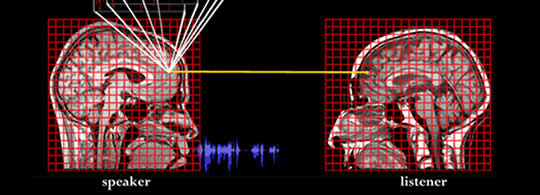Stories Synchronize Brains
An ongoing story (so to speak) here at Neuromarketing is the power of stories to engage readers and listeners. Now, there’s new brain scan evidence that shows a startling phenomenon: when one person tells a story and the other actively listens, their brains actually begin to synchronize.
A new study from Princeton University reports that a female student of lead investigator, Uri Hasson, can project her own brain activity onto another person, forcing the person’s neural activity to closely mirror that in her own brain. The process is otherwise known as speech…
The researchers found that when the two people communicate, neural activity over wide regions of their brains becomes almost synchronous, with the listener’s brain activity patterns mirroring those sweeping through the speaker’s brain, albeit with a short lag of about one second. If the listener, however, fails to comprehend what the speaker is trying to communicate, their brain patterns decouple. [From Scientific American – Mind and Brain – Of two minds: Listener brain patterns mirror those of the speaker by R. Douglas Fields.]
The brain scans show that such neural coupling doesn’t always occur – it only happened when the listener was paying attention and understood the story. (It’s entirely possible, of course, that conversations other than stories can also cause similar brain synchronization.)
This work seems most relevant to speakers and in-person salespeople. If one can engage the audience or sales prospects to the point where their brains are mirroring (or even anticipating) one’s own brain activity, they are clearly fully engaged. In this condition, one is far more likely to be successful, whether the objective is to inform or convince. And, pending further research on this “mind meld” phenomenon, we know that at least stories can cause the brains of speakers and listeners to synchronize.
View the whole paper at PNAS.org: Speaker–listener neural coupling underlies successful communication by Greg J. Stephens, Lauren J. Silbert and Uri Hasson.


